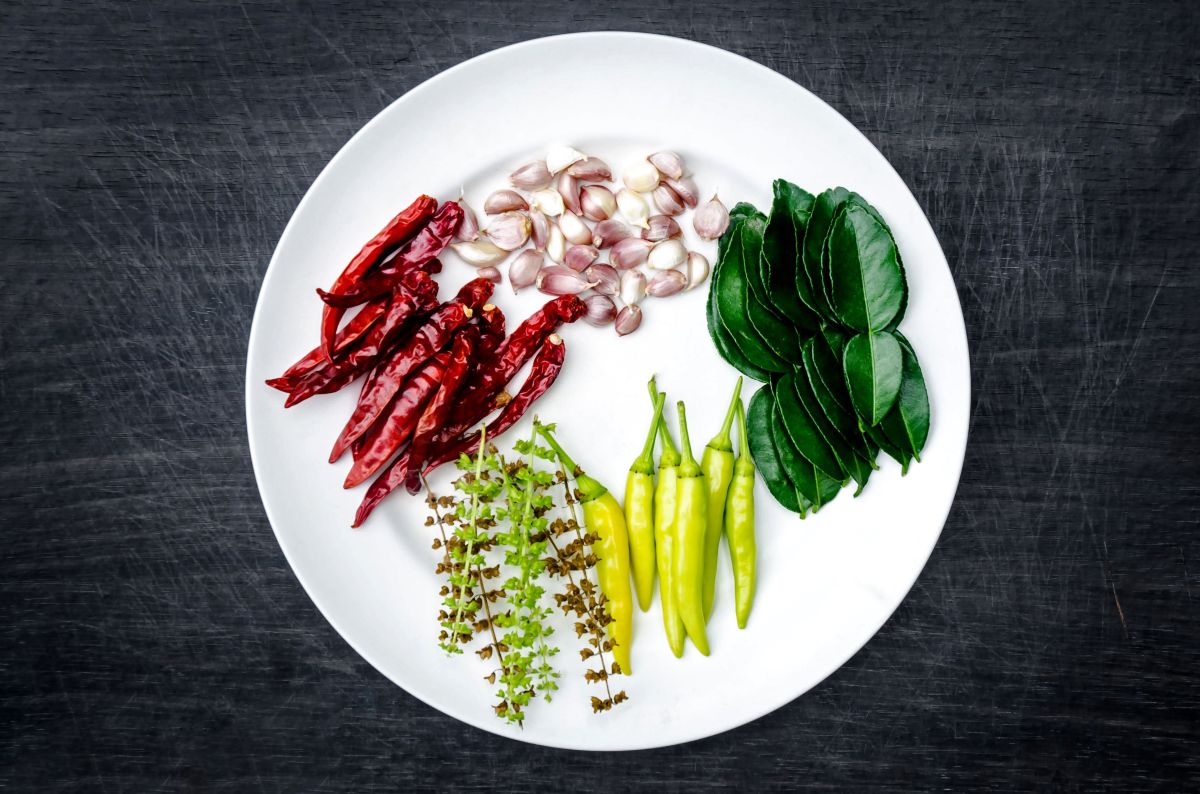Discover the vibrant world of Thai cuisine, where fiery spices meet heart-healthy ingredients. This exploration delves into the art of balancing flavor and wellness, showcasing recipes that are both delicious and beneficial for your cardiovascular system. We’ll uncover the secrets of using traditional Thai spices and ingredients to create flavorful dishes that support your heart health, without sacrificing the rich and aromatic tastes that define Thai food.
From aromatic curries to refreshing salads, we’ll guide you through a collection of adaptable recipes, revealing how to modify traditional dishes to reduce sodium, fat, and sugar while preserving the authentic Thai flavors you crave. Learn about the nutritional powerhouses found in common Thai ingredients like ginger, garlic, and lemongrass, and discover how to incorporate them into your daily diet for optimal heart health. We’ll also provide a sample three-day meal plan, demonstrating how to seamlessly integrate these delicious and heart-friendly recipes into your weekly routine.
Adapting Traditional Thai Recipes for Heart Health

Thai cuisine, renowned for its vibrant flavors and aromatic spices, can be adapted to support heart health without sacrificing the deliciousness that defines it. By making mindful substitutions and employing healthier cooking techniques, we can enjoy the rich tapestry of Thai tastes while promoting cardiovascular well-being. This involves reducing sodium, fat, and sugar, while enhancing the abundance of fresh vegetables and fruits inherent in many traditional recipes.
Sodium Reduction in Thai Dishes
High sodium intake contributes significantly to high blood pressure, a major risk factor for heart disease. Traditional Thai recipes often rely heavily on fish sauce and soy sauce for umami depth. However, these can be significantly reduced without compromising taste. Instead of relying solely on these salty ingredients, we can build flavor through the skillful use of fresh herbs like lemongrass, galangal, kaffir lime leaves, and chilies. These aromatic elements contribute a complex flavor profile that naturally masks the need for excessive salt. Furthermore, using low-sodium soy sauce or tamari, or even reducing the amount of fish sauce by half, and supplementing with a touch of lime juice for acidity, can make a noticeable difference. A well-balanced blend of herbs and spices creates a symphony of flavors, rendering excessive salt unnecessary.
Fat Modification in Thai Cooking
Many traditional Thai dishes utilize coconut milk, which is rich in saturated fat. While coconut milk contributes to the creamy texture and richness of curries, using light coconut milk or reducing the quantity significantly can substantially lower the saturated fat content. Alternatively, substituting some of the coconut milk with vegetable broth or water can lighten the dish without sacrificing its essence. Furthermore, the choice of cooking oil is crucial. Opting for healthier oils like olive oil or canola oil, which are lower in saturated fat and higher in monounsaturated fats, can contribute positively to heart health. Remember that the cooking process itself impacts fat content; stir-frying, a common Thai cooking method, uses minimal oil, unlike deep frying.
Sugar Reduction Strategies in Thai Cuisine
While many Thai dishes incorporate natural sugars from fruits, added sugar can significantly impact blood sugar levels. This is particularly true in desserts and some sweet and sour dishes. Reducing the amount of added sugar in these dishes is a simple yet effective way to improve their heart health profile. Instead of relying on refined sugar, using natural sweeteners like honey or maple syrup in moderation can offer a healthier alternative, though always in smaller quantities than refined sugar. Additionally, balancing the sweetness with the other flavor components – sour, salty, bitter, and umami – creates a more nuanced and less reliant-on-sugar taste experience. The vibrant flavors of Thai cuisine itself can often compensate for a reduction in added sugar.
Healthy Cooking Methods in Thai Cuisine
Thai cuisine naturally lends itself to heart-healthy cooking methods. Steaming, for instance, preserves the nutrients and vibrant colors of vegetables while minimizing the need for added fats. Stir-frying, a cornerstone of Thai cooking, utilizes high heat and minimal oil, allowing for quick cooking times and nutrient retention. Grilling, another popular method, imparts a smoky flavor to meats and vegetables while reducing fat content. These techniques allow for the creation of flavorful and heart-healthy dishes that maintain the authentic essence of Thai cuisine. Consider grilling lean proteins like chicken or fish, and steaming or stir-frying a colorful array of vegetables. This combination retains the visual appeal and the complex flavors characteristic of Thai cooking, while significantly improving its nutritional profile.
Ingredient Spotlight
Thai cuisine, renowned for its vibrant flavors and aromatic spices, also offers a wealth of heart-healthy ingredients. Many traditional components contribute not only to the delicious taste but also to the overall well-being of those who enjoy it. By focusing on these beneficial elements, we can savor the rich tapestry of Thai flavors while supporting cardiovascular health.
The following ingredients are commonly used in Thai cooking and offer significant nutritional benefits, contributing to a balanced and heart-healthy diet.
- Ginger: A pungent root with a warm, spicy flavor, ginger is a powerhouse of antioxidants. Its anti-inflammatory properties help reduce inflammation throughout the body, including in blood vessels, potentially lowering the risk of heart disease. Ginger also aids in digestion and may help regulate blood sugar levels, further contributing to cardiovascular health. The vibrant orange hue of fresh ginger, often seen peeled and finely minced or julienned in Thai dishes, speaks to its potent properties.
- Garlic: This pungent bulb, a staple in Thai cooking, is rich in allicin, a compound with potent antioxidant and anti-inflammatory effects. Studies suggest that regular garlic consumption may help lower blood pressure and cholesterol levels, reducing the risk of heart disease and stroke. The strong, aromatic scent of crushed garlic, often released during the initial stages of Thai cooking, heralds its beneficial properties.
- Lemongrass: This fragrant herb, with its citrusy aroma and subtle lemony flavor, is widely used in Thai soups and curries. Lemongrass possesses anti-inflammatory properties and may help lower cholesterol levels. Its refreshing scent, often used to infuse broths and sauces, is a welcome addition to any heart-healthy Thai meal. The pale green stalks, often bruised or pounded to release their oils, add both flavor and visual appeal.
- Turmeric: Known for its vibrant golden-yellow color and earthy flavor, turmeric contains curcumin, a potent anti-inflammatory compound. Curcumin has shown promise in reducing inflammation and improving blood vessel function, potentially benefiting heart health. The rich color of turmeric, often used to tint Thai curries a vibrant yellow-orange, is a visual indicator of its beneficial properties.
- Chili Peppers (in moderation): While spice is a hallmark of Thai cuisine, chili peppers, in moderation, can offer heart-health benefits. Capsaicin, the compound responsible for the heat, has been shown to have antioxidant and anti-inflammatory effects. However, excessive consumption can irritate the digestive system, so moderation is key. The vivid red or green hues of Thai chilies, adding both heat and visual vibrancy to dishes, should be enjoyed judiciously.
Ginger-Infused Chicken Stir-Fry
This recipe showcases ginger’s heart-healthy benefits while delivering a flavorful and satisfying Thai-inspired dish. The balance of spice and heart-healthy ingredients creates a delicious and nutritious meal.
- Prepare the Ingredients: Dice 1 lb boneless, skinless chicken breast into bite-sized pieces. Thinly slice 1 large piece of fresh ginger (about 2 inches). Mince 2 cloves of garlic. Chop 1 red bell pepper and 1 cup broccoli florets. Set aside 1/4 cup low-sodium chicken broth.
- Stir-fry the Chicken: Heat 1 tablespoon of olive oil in a wok or large skillet over medium-high heat. Add the chicken and stir-fry until browned and cooked through. Remove the chicken from the wok and set aside.
- Sauté Aromatics: Add the ginger and garlic to the wok and sauté for about 30 seconds, until fragrant. The aroma will fill your kitchen with the warm, spicy scent of fresh ginger.
- Add Vegetables: Add the bell pepper and broccoli to the wok and stir-fry for 2-3 minutes, until slightly tender-crisp. The vibrant colors of the vegetables will create a visually appealing dish.
- Combine and Simmer: Return the chicken to the wok. Add the chicken broth and bring to a simmer. The broth will create a light sauce, coating the chicken and vegetables.
- Season and Serve: Season with a pinch of salt, pepper, and a dash of soy sauce (low sodium preferred). Serve hot over brown rice or quinoa for a complete and balanced meal.
Creating a Balanced Thai Meal Plan
A balanced Thai meal plan can be both delicious and beneficial for heart health. By carefully selecting ingredients and controlling portion sizes, you can enjoy the vibrant flavors of Thai cuisine while supporting your cardiovascular well-being. This three-day sample plan showcases how to incorporate heart-healthy principles into traditional Thai recipes. Remember to adjust portion sizes based on your individual caloric needs and activity levels.
A Three-Day Sample Thai Meal Plan
The following table Artikels a three-day meal plan incorporating heart-healthy Thai recipes. Each meal is designed to be balanced in terms of macronutrients and rich in essential vitamins and minerals. This is merely a sample plan, and you can adapt it based on your preferences and dietary needs. Always consult with a healthcare professional or registered dietitian before making significant dietary changes.
| Day | Meal | Recipe/Description |
|---|---|---|
| Day 1 | Lunch | Tom Kha Gai (Coconut Soup with Chicken): A lighter version using lean chicken breast, reduced coconut milk, and plenty of vegetables like mushrooms, lemongrass, and galangal. Served with a side of brown rice. |
| Day 1 | Dinner | Steamed Fish with Ginger and Lime: A flavorful and healthy dish featuring a lean white fish, such as cod or snapper, steamed with ginger, lime juice, and a touch of chili for a mild spice kick. Served with a side of stir-fried bok choy. |
| Day 2 | Lunch | Green Curry with Tofu and Vegetables: A vibrant green curry made with coconut milk (used sparingly), plenty of vegetables such as broccoli, bell peppers, and bamboo shoots, and firm tofu as a protein source. Served with a small portion of quinoa. |
| Day 2 | Dinner | Chicken and Vegetable Stir-fry with Brown Rice Noodles: Lean chicken breast stir-fried with a variety of colorful vegetables like carrots, snap peas, and broccoli florets in a light soy sauce-based sauce. Served over brown rice noodles. |
| Day 3 | Lunch | Spicy Shrimp Salad with Mango and Avocado: A refreshing salad featuring grilled shrimp, ripe mango, avocado, and a light vinaigrette dressing. The spice comes from a small amount of chili flakes. |
| Day 3 | Dinner | Pad See Ew with Chicken or Tofu: A slightly adapted Pad See Ew using brown rice noodles and plenty of vegetables, reducing the amount of sauce and choosing either lean chicken or tofu as the protein. |
Nutritional Value and Health Benefits
This meal plan emphasizes lean protein sources (chicken, fish, tofu), a variety of colorful vegetables packed with vitamins, minerals, and antioxidants, and whole grains (brown rice, quinoa, brown rice noodles). The use of healthy fats, such as those found in avocados and coconut milk (in moderation), provides essential nutrients while contributing to satiety. The reduced sodium content and limited use of saturated fats contribute to maintaining healthy blood pressure and cholesterol levels. The inclusion of spices like ginger, garlic, and chili peppers can offer anti-inflammatory benefits.
Portion Control and Mindful Eating
Portion control is crucial for maintaining a healthy weight and supporting heart health. Even healthy foods can contribute to weight gain if consumed in excessive amounts. Mindful eating, paying attention to your body’s hunger and fullness cues, helps you to eat only until you are satisfied, not stuffed. Savoring each bite and enjoying the flavors of the food without distractions promotes better digestion and a more positive relationship with food. Using smaller plates and bowls can also visually aid in portion control. Remember that even a heart-healthy diet requires balance and moderation.
Embarking on a culinary journey through heart-healthy Thai cuisine offers a delightful path to wellness. By understanding the principles of balancing spice and nutrition, you can create flavorful meals that nourish your body and tantalize your taste buds. The recipes and techniques presented here empower you to enjoy the vibrant tastes of Thailand while actively supporting your cardiovascular health. Remember, mindful eating and portion control are key components of a healthy lifestyle, allowing you to savor each bite of these delicious and wholesome dishes.
Answers to Common Questions
Can I adjust the spice levels in these recipes?
Absolutely! Spice levels are easily customizable to your preference. Start with less chili and add more gradually to your liking.
Are these recipes suitable for vegetarians/vegans?
Many Thai recipes are naturally vegetarian-friendly. However, some may contain fish sauce or other non-vegetarian ingredients. Adaptations for vegetarian or vegan diets are possible by substituting appropriate alternatives.
How can I store leftover Thai food?
Store leftovers in airtight containers in the refrigerator for up to 3-4 days. Always allow food to cool completely before refrigerating.
What are some good substitutes for coconut milk?
Depending on the recipe, you can substitute coconut milk with light coconut milk, full-fat coconut milk, or even plant-based milk alternatives like almond or soy milk, though the flavor will change slightly.


